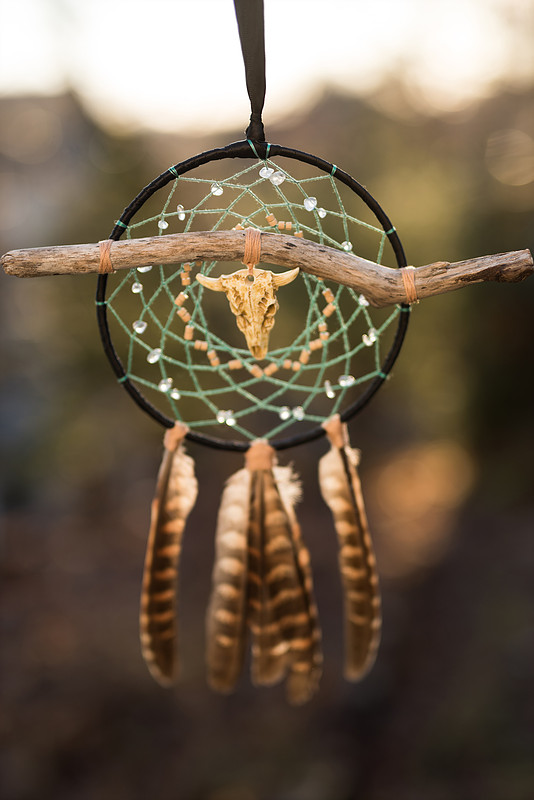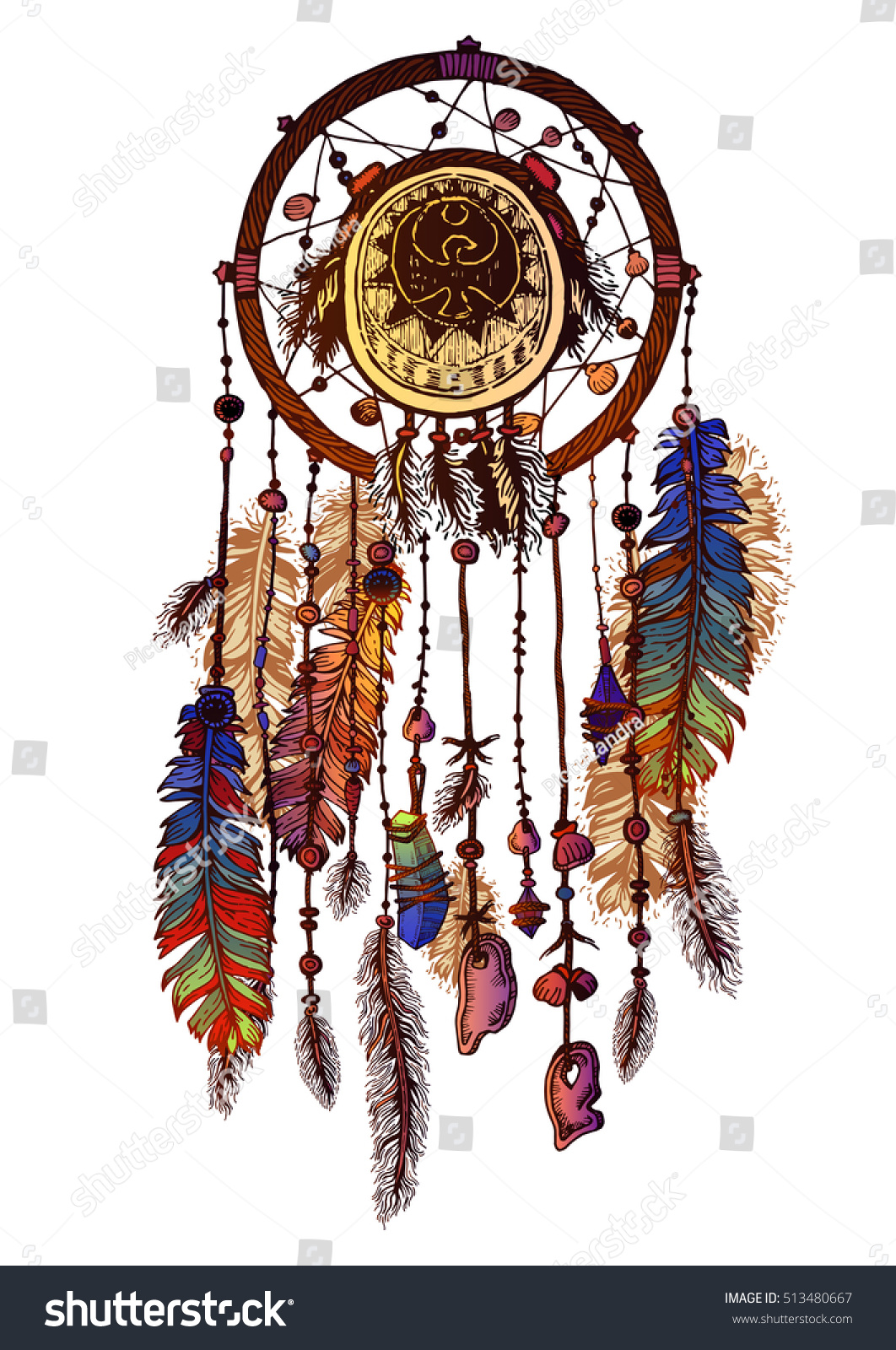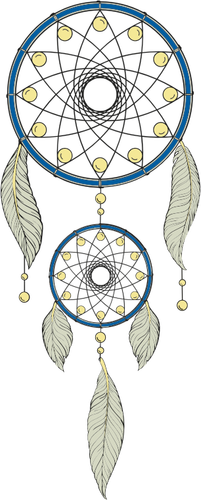Ojibway Dreamcatcher Legends: Traditional ideas about dreamcatchers and their meaning from Ojibway culture. Legend of the Dream Catcher: A Lakota version of the dreamcatcher story featuring the trickster Iktomi. Native American Dreams: The meanings and interpretation of dreams in various North American Indian cultures. It was traditional to put a feather in the center of the dream catcher; it means breath, or air. It is essential for life. A baby watching the air playing with the feather on her cradleboard was entertained while also being given a lesson on the importance of good air. Dream Catcher, Handcrafted, Handwoven, Native American Indian Traditional Ojibwa Crafted, Minnesota Chippewa Tribe, Leech Lake Reservation. BINESHIIstore 5 out of 5 stars (164).
Today dream catchers are made by Native American artists from many Nations; a great deal of people are under the impression that the Lakota/Dakota/Nakota (called Sioux by others) originated the dreamcatcher... There are many Native American stories and legends about spiders and webs, but the Ojibwe (called Chippewa by others) originated the dream catcher. A look at the long tradition of storytelling, oral histories, passed down parent to child, generation after generation, clears up any confusion about the origin of dream catchers.
Frances Densmore conducted an extensive study of material culture of the Ojibwe/Chippewa living in Minnesota, Wisconsin and Ontario, Canada in the early 1900's and the information is presented in the book, Chippewa Customs, published by Minnesota Historical Society Press (St. Paul) in 1979. Densmore describes that articles representing spider webs were usually hung from the hoop of a child's cradle board, and it was said that 'they catch and hold everything evil as a spider's web catches and holds everything that comes into contact with it'. These 'dream catchers' were wooden hoops with a 3 1/2 in. diameter, filled with a web made of nettle-stalk cord that was dyed red with bloodroot and wild plum inner bark. It is interesting to note that the 'weave' of the dream catcher photographed in Densmore's work is different from that usually done today. By the early 1900's, dark red yarn had been substituted for plant fiber in constructing the web by the Ojibwe. Densmore also mentions a similar netted-hoop made by the Pawnee to represent the Spider-Woman, a spirit who controlled the buffalo.
The Ojibwe, whose traditional homeland is around the Great Lakes region, have ancient stories about the dreamcatcher, how it 'came to be', why it is used, and how it should be made. A while back there was quite a discussion about the origin of the dream catcher on the soc.culture.native Newsgroups and on the Native-L Listserver.

| Contemporary dreamcatcher with traditional Chippewa weave, made by my friend Michael O'Neill (Red Lake Band of Chippewa) and his wife (Fond-du-lac band of Chippewa). 'My wife and I had went out one evening and gathered up some red willow... the willow is wrapped with one continuous piece of yarn including the web... it takes about an hour to make....I use a deep red yarn... like bloodroot'. |
from Lyn Dearborn
In response to a question about the FIRST origin of Dream Catchers,
Nov. 1, 1995 to the Native-l Listserver.
Long ago in the ancient world of the Ojibwe Nation, the Clans were all located in one general area of that place known as Turtle Island. This is the way that the old Ojibwe storytellers say how Asibikaashi (Spider Woman) helped Wanabozhoo bring giizis (sun) back to the people. To this day, Asibikaashi will build her special lodge before dawn. If you are awake at dawn, as you should be, look for her lodge and you will see this miracle of how she captured the sunrise as the light sparkles on the dew which is gathered there.
Asibikaasi took care of her children, the people of the land, and she continues to do so to this day. When the Ojibwe Nation dispersed to the four corners of North America, to fill a prophecy, Asibikaashi had a difficult time making her journey to all those cradle boards, so the mothers, sisters, & Nokomis (grandmothers) took up the practice of weaving the magical webs for the new babies using willow hoops and sinew or cordage made from plants. It is in the shape of a circle to represent how giizis travels each day across the sky. The dream catcher will filter out all the bad bawedjigewin (dreams) & allow only good thoughts to enter into our minds when we are just abinooji. You will see a small hole in the center of each dream catcher where those good bawadjige may come through. With the first rays of sunlight, the bad dreams would perish.
When we see little asibikaashi, we should not fear her, but instead respect and protect her. In honor of their origin, the number of points where the web connected to the hoop numbered 8 for Spider Woman's eight legs or 7 for the Seven Prophecies.
in a cradle board [Densmore 1979]. |

It was traditional to put a feather in the center of the dream catcher; it means breath, or air. It is essential for life. A baby watching the air playing with the feather on her cradleboard was entertained while also being given a lesson on the importance of good air. This lesson comes forward in the way that the feather of the owl is kept for wisdom (a woman's feather) & the eagle feather is kept for courage (a man's feather). This is not to say that the use of each is restricted by gender, but that to use the feather each is aware of the gender properties she/he is invoking. (Indian people, in general, are very specific about gender roles and identity.) The use of gem stones, as we do in the ones we make for sale, is not something that was done by the old ones. Government laws have forbidden the sale of feathers from our sacred birds, so using four gem stones, to represent the four directions, and the stones used by western nations were substituted by us. The woven dream catchers of adults do not use feathers.
Dream catchers made of willow and sinew are for children, and they are not meant to last. Eventually the willow dries out and the tension of the sinew collapses the dream catcher. That's supposed to happen. It belies the temporary-ness of youth. Adults should use dream catchers of woven fiber which is made up to reflect their adult 'dreams.' It is also customary in many parts of Canada and the Northeastern U.S. to have the dream catchers be a tear-drop/snow shoe shape.
The above story is a combination of information gathered by Lyn Dearborn, from California, and Mary Ritchie, of the Northern Woodlands, with assistance from Canadian elders. Miigwetch!
Thanks also to Theresa and Aandek for the Ojibwe terms & translations for dream catchers on Rob's Ojibwe Bulletin Board!
from a July 26, 1995 submission to the soc.culture.native Newsgroup
How To Make A Traditional Dream Catcher
 Return to Willow Branches and Other Twigs and Roots Background
Return to Willow Branches and Other Twigs and Roots BackgroundBranches, Twigs & Roots Bibliography and Books to Buy On-Line
| Text and Graphics © 1994 - Tara Prindle unless otherwise cited. |
Long ago in the ancient world of the Ojibwe Nation, the Clans were all located in one general area of that place known as Turtle Island. This is the way that the old Ojibwe storytellers say how Asibikaashi (Spider Woman) helped Wanabozhoo bring giizis (sun) back to the people. To this day, Asibikaashi will build her special lodge before dawn. If you are awake at dawn, as you should be, look for her lodge and you will see this miracle of how she captured the sunrise as the light sparkles on the dew which is gathered there.

Asibikaasi took care of her children, the people of the land, and she continues to do so to this day. When the Ojibwe Nation dispersed to the four corners of North America, to fill a prophecy, Asibikaashi had a difficult time making her journey to all those cradle boards, so the mothers, sisters, & Nokomis (grandmothers) took up the practice of weaving the magical webs for the new babies using willow hoops and sinew or cordage made from plants. It is in the shape of a circle to represent how giizis travels each day across the sky. The dream catcher will filter out all the bad bawedjigewin (dreams) & allow only good thoughts to enter into our minds when we are just abinooji. You will see a small hole in the center of each dream catcher where those good bawadjige may come through. With the first rays of sunlight, the bad dreams would perish. When we see little asibikaashi, we should not fear her, but instead respect and protect her. In honor of their origin, the number of points where the web connected to the hoop numbered 8 for Spider Woman’s eight legs or 7 for the Seven Prophecies.
Traditional Dream Catcher Kit
It was traditional to put a feather in the center of the dream catcher; it means breath, or air. It is essential for life. A baby watching the air playing with the feather on her cradleboard was entertained while also being given a lesson on the importance of good air. This lesson comes forward in the way that the feather of the owl is kept for wisdom (a woman’s feather) & the eagle feather is kept for courage (a man’s feather). This is not to say that the use of each is restricted by gender, but that to use the feather each is aware of the gender properties she/he is invoking. (Indian people, in general, are very specific about gender roles and identity.) The use of gem stones, as we do in the ones we make for sale, is not something that was done by the old ones. Government laws have forbidden the sale of feathers from our sacred birds, so using four gem stones, to represent the four directions, and the stones used by western nations were substituted by us. The woven dream catchers of adults do not use feathers.
Dream catchers made of willow and sinew are for children, and they are not meant to last. Eventually the willow dries out and the tension of the sinew collapses the dream catcher. That’s supposed to happen. It belies the temporary-ness of youth. Adults should use dream catchers of woven fiber which is made up to reflect their adult “dreams.” It is also customary in many parts of Canada and the Northeastern U.S. to have the dream catchers be a tear-drop/snow shoe shape.